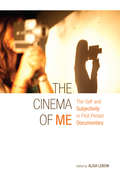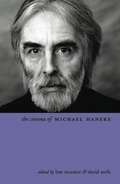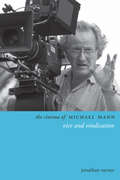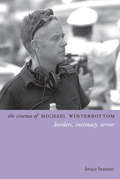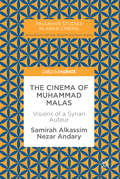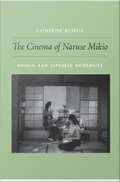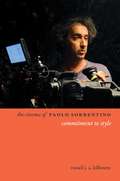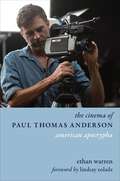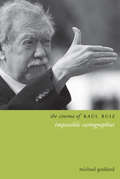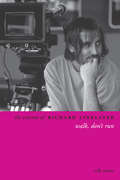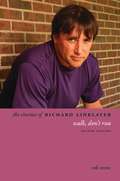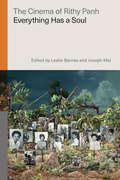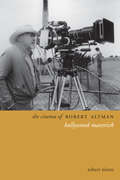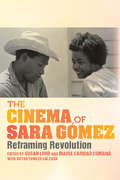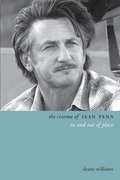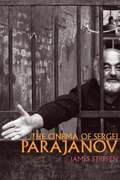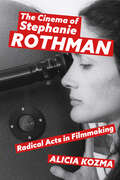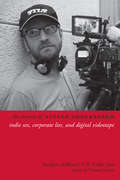- Table View
- List View
The Cinema of Me: The Self and Subjectivity in First Person Documentary (Nonfictions)
by Alisa Lebow ed. Preface by Michael Renov.When a filmmaker makes a film with herself as a subject, she is already divided as both the subject matter of the film and the subject making the film. The two senses of the word are immediately in play – the matter and the maker—thus the two ways of being subjectified as both subject and object. Subjectivity finds its filmic expression, not surprisingly, in very personal ways, yet it is nonetheless shaped by and in relation to collective expressions of identity that can transform the cinema of 'me' into the cinema of 'we'. Leading scholars and practitioners of first-person film are brought together in this groundbreaking collection to consider the theoretical, ideological, and aesthetic challenges wrought by this form of filmmaking in its diverse cultural, geographical, and political contexts.
The Cinema of Michael Haneke: Europe Utopia
by Ben Mccann David SorfaMichael Haneke is one of the most important directors working in Europe today, with films such as Funny Games (1997), Code Unknown (2000), and Hidden (2005) interrogating modern ethical dilemmas with forensic clarity and merciless insight. Haneke's films frequently implicate both the protagonists and the audience in the making of their misfortunes, yet even in the barren nihilism of The Seventh Continent (1989) and Time of the Wolf (2003) a dark strain of optimism emerges, releasing each from its terrible and inescapable guilt. It is this contingent and unlikely possibility that we find in Haneke's cinema: a utopian Europe. This collection celebrates, explicates, and sometimes challenges the worldview of Haneke's films. It examines the director's central themes and preoccupations--bourgeois alienation, modes and critiques of spectatorship, the role of the media--and analyzes otherwise marginalized aspects of his work, such as the function of performance and stardom, early Austrian television productions, the romanticism of The Piano Teacher (2001), and the 2007 shot-for-shot remake of Funny Games.
The Cinema of Michael Haneke: Europe Utopia (Directors' Cuts)
by David Ben McCann Eds. SorfaMichael Haneke is one of the most important directors working in Europe today, with films such as Funny Games (1997), Code Unknown (2000), and Hidden (2005) interrogating modern ethical dilemmas with forensic clarity and merciless insight. Haneke's films frequently implicate both the protagonists and the audience in the making of their misfortunes, yet even in the barren nihilism of The Seventh Continent (1989) and Time of the Wolf (2003) a dark strain of optimism emerges, releasing each from its terrible and inescapable guilt. It is this contingent and unlikely possibility that we find in Haneke's cinema: a utopian Europe. This collection celebrates, explicates, and sometimes challenges the worldview of Haneke's films. It examines the director's central themes and preoccupations—bourgeois alienation, modes and critiques of spectatorship, the role of the media—and analyzes otherwise marginalized aspects of his work, such as the function of performance and stardom, early Austrian television productions, the romanticism of The Piano Teacher (2001), and the 2007 shot-for-shot remake of Funny Games.
The Cinema of Michael Mann
by Jonathan RaynerMichael Mann is one of the most important American filmmakers of the past forty years. His films exhibit the existential concerns of art cinema, articulated through a conspicuous and recognizable visual style and yet integrated within classical Hollywood narrative and genre frameworks. Since his beginnings as a screenwriter in the 1970s, Mann has become a key figure within contemporary American popular culture as writer, director, and producer for film and television. This volume offers a detailed study of Mann's feature films, from The Jericho Mile (1979) to Public Enemies (2009), with consideration also being given to parallels in the production, style, and characterization in his television work. It explores Mann's relationship with classical genres, his thematic concentration on issues of morality and masculinity, his film adaptations from literature, and the development and significance of his trademark visual style within modern American cinema.
The Cinema of Michael Mann: Vice and Vindication (Directors' Cuts)
by Jonathan RaynerMichael Mann is one of the most important American filmmakers of the past forty years. His films exhibit the existential concerns of art cinema, articulated through a conspicuous and recognizable visual style and yet integrated within classical Hollywood narrative and genre frameworks. Since his beginnings as a screenwriter in the 1970s, Mann has become a key figure within contemporary American popular culture as writer, director, and producer for film and television. This volume offers a detailed study of Mann's feature films, from The Jericho Mile (1979) to Public Enemies (2009), with consideration also being given to parallels in the production, style, and characterization in his television work. It explores Mann's relationship with classical genres, his thematic concentration on issues of morality and masculinity, his film adaptations from literature, and the development and significance of his trademark visual style within modern American cinema.
The Cinema of Michael Winterbottom
by Bruce BennettThis comprehensive study of prolific British filmmaker Michael Winterbottom explores the thematic, stylistic, and intellectual consistencies running through his eclectic and controversial body of work. Within an overview of his career, this volume undertakes a close analysis of fifteen of Winterbottom's films ranging from TV dramas to transnational coproductions featuring Hollywood stars, and from documentaries to costume films. This analysis is grounded in a consideration of Winterbottom's collaborative working practices, the political and cultural contexts of the work, and its critical reception. Arguing that Winterbottom's work comprises a 'cinema of borders', it examines its treatment of sexuality, class, ethnicity, national and international politics. The book argues that what is evident in Winterbottom's oeuvre is the search for an adequate means of narrating inequality, injustice, and violence. Drawing out the tensions, contradictions, and border-crossing strategies of these films, The Cinema of Michael Winterbottom highlights the complex political aesthetic that structures the work of this singular director.
The Cinema of Michael Winterbottom: Borders, Intimacy, Terror (Directors' Cuts)
by Bruce BennettThis comprehensive study of prolific British filmmaker Michael Winterbottom explores the thematic, stylistic, and intellectual consistencies running through his eclectic and controversial body of work. This volume undertakes a close analysis of a TV series directed by Winterbottom and sixteen of his films ranging from television dramas to transnational co-productions featuring Hollywood stars, and from documentaries to costume films. The critique is centered on Winterbottom's collaborative working practices, political and cultural contexts, and critical reception. Arguing that his work delineates a 'cinema of borders', this study examines Winterbottom's treatment of sexuality, class, ethnicity, and national and international politics, as well as his quest to adequately narrate inequality, injustice, and violence.
The Cinema of Muhammad Malas: Visions of a Syrian Auteur (Palgrave Studies in Arab Cinema)
by Samirah Alkassim Nezar AndaryThis book provides an in-depth and intimate study of the cinema of Muhammad Malas. One of the well-known auteurs of Arab and Syrian cinema, Malas’s distinctive cinematic project has always confronted the social and political issues of his time. From feature films Dreams of the City, The Night, Bab al Maqam (Passion), and Ladder to Damascus to documentaries such as The Dream and Aleppo: Maqamat of Pleasure, Malas’s films challenge and explore Arab culture and history. Archival images run through the chapters of this book which combines insightful interviews with excerpts from Malas’s literary works and critical explorations of his cinematic style and thematic concerns. The book concludes with Malas’s own words, sharing the treatment of his film project Cinema al-Dunya.
The Cinema of Naruse Mikio: Women and Japanese Modernity
by Catherine RussellOne of the most prolific and respected directors of Japanese cinema, Naruse Mikio (1905-69) made eighty-nine films between 1930 and 1967. Little, however, has been written about Naruse in English, and much of the writing about him in Japanese has not been translated into English. With The Cinema of Naruse Mikio, Catherine Russell brings deserved critical attention to this under-appreciated director. Besides illuminating Naruse's contributions to Japanese and world cinema, Russell's in-depth study of the director sheds new light on the Japanese film industry between the 1930s and the 1960s. Naruse was a studio-based director, a company man renowned for bringing films in on budget and on time. During his long career, he directed movies in different styles of melodrama while displaying a remarkable continuity of tone. His films were based on a variety of Japanese literary sources and original scripts; almost all of them were set in contemporary Japan. Many were "women's films. " They had female protagonists, and they depicted women's passions, disappointments, routines, and living conditions. While neither Naruse or his audiences identified themselves as "feminist," his films repeatedly foreground, if not challenge, the rigid gender norms of Japanese society. Given the complex historical and critical issues surrounding Naruse's cinema, a comprehensive study of the director demands an innovative and interdisciplinary approach. Russell draws on the critical reception of Naruse in Japan in addition to the cultural theories of Harry Harootunian, Miriam Hansen, and Walter Benjamin. She shows that Naruse's movies were key texts of Japanese modernity, both in the ways that they portrayed the changing roles of Japanese women in the public sphere and in their depiction of an urban, industrialized, mass-media-saturated society.
The Cinema of Paolo Sorrentino: Commitment to Style (Directors' Cuts)
by Russell KilbournPaolo Sorrentino, director of Il Divo (2008) and The Great Beauty (2013) and creator of the HBO series The Young Pope (2016), has emerged as one of the most compelling figures in twenty-first-century European film. From his earliest productions to his more recent transnational works, Sorrentino has paid homage to Italy’s cinematic past while telling stories of masculine characters whose sense of self seems to be on the brink of dissolution. Together with his usual collaborators (including cinematographer Luca Bigazzi and editor Cristiano Travagliolo) and actors (chief among them Toni Servillo), Sorrentino has produced an incisive depiction of the contemporary European condition by means of an often spectacular postclassical style that nevertheless continues postwar Italian film’s tradition of political commitment.This book is a critical examination of Sorrentino’s work, focusing on his emergence as a preeminent transnational auteur. Russell J. A. Kilbourn offers close readings of Sorrentino’s feature films and television output from One Man Up (2001) to The Young Pope (2016) and Loro (2018), featuring in-depth analyses of the director’s exuberant and intensified film style. Addressing the crucial themes of Sorrentino’s output—including a masculine subject defined by a melancholic awareness of its own imminent demise, and a critique of the conventional cinematic representation of women—Kilbourn illuminates Sorrentino’s ability to suffuse postmodern elegies for the humanist worldview with a sense of social awareness and responsibility. Kilbourn also foregrounds Sorrentino’s contributions to the ongoing transformations of cinematic realism and the Italian and European art cinema traditions more broadly. The first English-language study of the acclaimed director’s oeuvre, The Cinema of Paolo Sorrentino demonstrates why he is considered one of the most dynamic figures making films today.
The Cinema of Paul Thomas Anderson: American Apocrypha (Directors' Cuts)
by Ethan WarrenPaul Thomas Anderson’s evolution from a brash, self-anointed “Indiewood” auteur to one of his generation’s most distinctive voices has been one of the most remarkable career trajectories in recent film history. From early efforts to emulate his cinematic heroes to his increasingly singular late films, Anderson has created a body of work that balances the familiar and the strange, history and myth: viewers feel perpetually off balance, unsure of whether to expect a pitch-black joke or a moment of piercing emotional resonance.This book provides the most complete account of Anderson’s career to date, encompassing his varied side projects and unproduced material; his personal and professional relationships with directors such as Jonathan Demme, Robert Altman, and Robert Downey Sr.; and his work as a director of music videos for Fiona Apple, Joanna Newsom, and Haim. Ethan Warren explores Anderson’s recurring thematic preoccupations—the fraught dynamics of gender and religious faith, biological and found families, and his native San Fernando Valley—as well as his screenwriting methods and his relationship to his influences. Warren argues that Anderson’s films conjure up an alternate American history that exaggerates and elides verifiable facts in search of a heightened truth marked by a deeper level of emotional hyperrealism. This book is at once an unconventional primer on Anderson’s films and a provocative reframing of what makes his work so essential.
The Cinema of Raul Ruiz
by Michael GoddardRaúl Ruiz, while considered one of the world's most significant filmmakers by several film critics, is yet to be the subject of any thorough engagement with his work in English. This volume sets out on this task by mapping, as fully as possible, Ruiz's cinematic trajectory across more than five decades of prolific work, up to his death in 2011; ranging from his earliest work in Chile to high-budget 'European' costume dramas culminating in Mysteries of Lisbon (2010). It does so by treating Ruiz's work -- with its surrealist, magic realist, popular cultural, and neo-Baroque sources -- as a type of 'impossible' cinematic cartography, mapping real, imaginary, and virtual spaces, and crossing between different cultural contexts, aesthetic strategies, and technical media. It argues that across the different phases of Ruiz's work identified, there are key continuities such as the invention of singular cinematic images and the interrogation of their possible and impossible combinations.
The Cinema of Raúl Ruiz: Impossible Cartographies (Directors' Cuts)
by Michael GoddardRaúl Ruiz, while considered one of the world's most significant filmmakers by several film critics, is yet to be the subject of any thorough engagement with his work in English. This volume sets out on this task by mapping, as fully as possible, Ruiz's cinematic trajectory across more than five decades of prolific work, up to his death in 2011; ranging from his earliest work in Chile to high-budget 'European' costume dramas culminating in Mysteries of Lisbon (2010). It does so by treating Ruiz's work—with its surrealist, magic realist, popular cultural, and neo-Baroque sources—as a type of 'impossible' cinematic cartography, mapping real, imaginary, and virtual spaces, and crossing between different cultural contexts, aesthetic strategies, and technical media. It argues that across the different phases of Ruiz's work identified, there are key continuities such as the invention of singular cinematic images and the interrogation of their possible and impossible combinations.
The Cinema of Richard Linklater: Walk, Don't Run
by Rob StoneFrom Slacker (1991) to The School of Rock (2003), from Before Sunrise (1995) to Before Sunset (2004), from the walking and talking of his no/low-budget American independent films to conversing with the philosophical traditions of the European art house, Richard Linklater's films are some of the most critical, political, and spiritual achievements of contemporary world cinema. Examinations of Linklater's collaborative working practices and deployment of rotoscoping and innovative distribution strategies all feature in this book, which aspires to walk and talk with the filmmaker and his films. Informed by a series of original interviews with the artist, in both his hometown and frequent film location of Austin, Texas, this study of the director who made Dazed and Confused (1993), A Scanner Darkly (2006), and Bernie (2011) explores the theoretical, practical, contextual, and metaphysical elements of these works along with his documentaries and side-projects and finds fanciful lives and lucid dreams have as much to do with his work as generally alternative notions of America, contemporary society, cinema, and time.
The Cinema of Richard Linklater: Walk, Don't Run (Directors' Cuts)
by Rob StoneFrom Slacker (1991), a foundational work of independent American cinema, to the Before trilogy, Richard Linklater’s critically acclaimed films and aesthetic ambition have earned him a place as one of the most important contemporary directors. In this second edition of The Cinema of Richard Linklater, Rob Stone shows how Linklater’s latest films have redefined our understanding of his work. He offers critical discussions and analysis of all of Linklater’s films, including Before Midnight (2013) and Everybody Wants Some!! (2016), as well as new interviews with Linklater and a chapter on Boyhood (2014), hailed as one of the best films of the twenty-first century.Stone explores the theoretical, practical, contextual, and metaphysical elements in Linklater’s filmography, especially his experimentation with cinematic representations of time and growth. He demonstrates that fanciful lives and lucid dreams are as central as alternative notions of America and time to Linklater’s films. Stone also considers Linklater’s collaborative working practices, his deployment of such techniques as rotoscoping, and his innovative distribution strategies. Thoroughly revised, updated, and extended, the book includes analysis of all of Linklater’s films, including Dazed and Confused (1993), Waking Life (2011), and A Scanner Darkly (2006) as well as his documentaries, short films, and side projects.
The Cinema of Richard Linklater: Walk, Don't Run (Directors' Cuts)
by Rob StoneFrom Slacker (1991) to The School of Rock (2003), from Before Sunrise (1995) to Before Sunset (2004), from the walking and talking of his no/low-budget American independent films to conversing with the philosophical traditions of the European art house, Richard Linklater's films are some of the most critical, political, and spiritual achievements of contemporary world cinema. Examinations of Linklater's collaborative working practices and deployment of rotoscoping and innovative distribution strategies all feature in this book, which aspires to walk and talk with the filmmaker and his films. Informed by a series of original interviews with the artist, in both his hometown and frequent film location of Austin, Texas, this study of the director who made Dazed and Confused (1993), A Scanner Darkly (2006), and Bernie (2011) explores the theoretical, practical, contextual, and metaphysical elements of these works along with his documentaries and side-projects and finds fanciful lives and lucid dreams have as much to do with his work as generally alternative notions of America, contemporary society, cinema, and time.Â
The Cinema of Rithy Panh: Everything Has a Soul (Global Film Directors)
by Joseph Mai Leslie BarnesBorn in 1964, Cambodian filmmaker Rithy Panh grew up in the midst of the Khmer Rouge’s genocidal reign of terror, which claimed the lives of many of his relatives. After escaping to France, where he attended film school, he returned to his homeland in the late 1980s and began work on the documentaries and fiction films that have made him Cambodia’s most celebrated living director. The fourteen essays in The Cinema of Rithy Panh explore the filmmaker’s unique aesthetic sensibility, examining the dynamic and sensuous images through which he suggests that “everything has a soul.” They consider how Panh represents Cambodia’s traumatic past, combining forms of individual and collective remembrance, and the implications of this past for Cambodia’s transition into a global present. Covering documentary and feature films, including his literary adaptations of Marguerite Duras and Kenzaburō Ōe, they examine how Panh’s attention to local context leads to a deep understanding of such major themes in global cinema as justice, imperialism, diaspora, gender, and labor. Offering fresh takes on masterworks like The Missing Picture and S-21 while also shining a light on the director’s lesser-known films, The Cinema of Rithy Panh will give readers a new appreciation for the boundless creativity and ethical sensitivity of one of Southeast Asia’s cinematic visionaries.
The Cinema of Robert Altman: Hollywod Maverick
by Robert NiemiIn a controversial and tumultuous filmmaking career that spanned nearly fifty years, Robert Altman mocked, subverted, or otherwise refashioned Hollywood narrative and genre conventions. Altman's idiosyncratic vision and propensity for formal experimentation resulted in an uneven body of work: some rank failures and intriguing near-misses, as well as a number of great films that are among the most influential works of New American Cinema. While Altman always professed to have nothing authoritative to say about the state of contemporary society, this volume surveys all of his major films in their sociohistorical context to reposition the director as a trenchant satirist and social critic of postmodern America, depicted as a lonely wasteland of fraudulent spectacle, exploitative social relations, and unfulfilled solitaries in search of elusive community.
The Cinema of Robert Altman: Hollywood Maverick (Directors' Cuts)
by Robert NiemiIn a controversial and tumultuous filmmaking career that spanned nearly fifty years, Robert Altman mocked, subverted, or otherwise refashioned Hollywood narrative and genre conventions. Altman's idiosyncratic vision and propensity for formal experimentation resulted in an uneven body of work: some rank failures and intriguing near-misses, as well as a number of great films that are among the most influential works of New American Cinema. While Altman always professed to have nothing authoritative to say about the state of contemporary society, this volume surveys all of his major films in their sociohistorical context to reposition the director as a trenchant satirist and social critic of postmodern America, depicted as a lonely wasteland of fraudulent spectacle, exploitative social relations, and unfulfilled solitaries in search of elusive community.
The Cinema of Sara Gómez: Reframing Revolution (New Directions in National Cinemas)
by Joshua Malitsky Inés María Martiatu Terry Lourdes Martínez-Echazábal Odette Casamayor-Cisneros Sergio Giral Luis García Mesa Devyn Spence Benson Rigoberto López Ana Serra Iván Arocha Montes de Oca Ricardo Acosta Alan West-Durán Sandra Abd’Allah-Alvarez RamírezThroughout the 1960s until her untimely death in 1974, Afro-Cuban filmmaker Sara Gómez engaged directly and courageously with the social, political, economic, and cultural transformations promised by the Cuban Revolution. Gómez directed numerous documentary films in 10 prolific years. She also made De cierta manera (One way or another), her only feature-length film. Her films navigate complex experiences of social class, race, and gender by reframing revolutionary citizenship, cultural memory, and political value. Not only have her inventive strategies become foundational to new Cuban cinema and feminist film culture, but they also continue to inspire media artists today who deal with issues of identity and difference. The Cinema of Sara Gómez assembles history, criticism, biography, methodology, and theory of Gómez's work in scholarly writing; interviews with friends and collaborators; the film script of De cierta manera; and a detailed and complete filmography.Featuring striking images, this anthology reorients how we tell Cuban cinema history and how we think about the intersections of race, gender, and revolution. By addressing Gómez's entire body of work, The Cinema of Sara Gómez unpacks her complex life and gives weight to her groundbreaking cinema.
The Cinema of Sean Penn
by Deane WilliamsAlthough best known as an Academy Award winning actor, Sean Penn's directorial works The Indian Runner (1991), The Crossing Guard (1995), The Pledge (2001), and Into the Wild (2007), consist of some of the most interesting and singular films made in the United States over the past twenty years. Each of Penn's directorial films and much of the cinema he has acted in are set in an immediate past in which a "stalled" time and a restricted locale apply narrative constraints. At the same time, these films all feature a sophisticated web of intertextual relations, involving actors, songs, books, films, and directors, and the political lineage to which Penn belongs, which reveal the deep cultural structures that concern each particular film.
The Cinema of Sean Penn: In and Out of Place (Directors' Cuts)
by Deane WilliamsAlthough best known as an Academy Award winning actor, Sean Penn's directorial works The Indian Runner (1991), The Crossing Guard (1995), The Pledge (2001), and Into the Wild (2007), consist of some of the most interesting and singular films made in the United States over the past twenty years. Each of Penn's directorial films and much of the cinema he has acted in are set in an immediate past in which a "stalled" time and a restricted locale apply narrative constraints. At the same time, these films all feature a sophisticated web of intertextual relations, involving actors, songs, books, films, and directors, and the political lineage to which Penn belongs, which reveal the deep cultural structures that concern each particular film.
The Cinema of Sergei Parajanov
by James SteffenSergei Parajanov (1924-90) flouted the rules of both filmmaking and society in the Soviet Union and paid a heavy personal price. An ethnic Armenian in the multicultural atmosphere of Tbilisi, Georgia, he was one of the most innovative directors of postwar Soviet cinema. Parajanov succeeded in creating a small but marvelous body of work whose style embraces such diverse influences as folk art, medieval miniature painting, early cinema, Russian and European art films, surrealism, and Armenian, Georgian, and Ukrainian cultural motifs. "The Cinema of Sergei Parajanov" is the first English-language book on the director's films and the most comprehensive study of his work. James Steffen provides a detailed overview of Parajanov's artistic career: his identity as an Armenian in Georgia and its impact on his aesthetics; his early films in Ukraine; his international breakthrough in 1964 with "Shadows of Forgotten Ancestors"; his challenging 1969 masterpiece, "The Color of Pomegranates," which was reedited against his wishes; his unrealized projects in the 1970s; and his eventual return to international prominence in the mid-to-late 1980s with "The Legend of the Surami Fortress" and "Ashik-Kerib. " Steffen also provides a rare, behind-the-scenes view of the Soviet film censorship process and tells the dramatic story of Parajanov's conflicts with the authorities, culminating in his 1973-77 arrest and imprisonment on charges related to homosexuality. Ultimately, the figure of Parajanov offers a fascinating case study in the complicated dynamics of power, nationality, politics, ethnicity, sexuality, and culture in the republics of the former Soviet Union.
The Cinema of Stephanie Rothman: Radical Acts in Filmmaking
by Alicia KozmaThe rare woman director working in second-wave exploitation, Stephanie Rothman (b. 1936) directed seven successful feature films, served as the vice president of an independent film company, and was the first woman to win the Directors Guild of America’s student filmmaking prize. Despite these career accomplishments, Rothman retired into relative obscurity. In The Cinema of Stephanie Rothman: Radical Acts in Filmmaking, author Alicia Kozma uses Rothman’s career as an in-depth case study, intertwining historical, archival, industrial, and filmic analysis to grapple with the past, present, and future of women’s filmmaking labor in Hollywood. Understanding second-wave exploitation filmmaking as a transitory space for the industrial development of contemporary Hollywood that also opened up opportunities for women practitioners, Kozma argues that understudied film production cycles provide untapped spaces for discovering women’s directorial work. The professional career and filmography of Rothman exemplify this claim. Rothman also serves as an apt example for connecting the structure of film histories to the persistent strictures of rhetorical language used to mark women filmmakers and their labor. Kozma traces these imbrications across historical archives. Adopting a diverse methodological approach, The Cinema of Stephanie Rothman shines a needed spotlight on the problems and successes of the memorialization of women’s directorial labor, connecting historical and contemporary patterns of gendered labor disparity in the film industry. This book is simultaneously the first in-depth scholarly consideration of Rothman, the debut of the most substantive archival materials collected on Rothman, and a feminist political intervention into the construction of film histories.
The Cinema of Steven Soderbergh: Indie Sex, Corporate Lies, and Digital Videotape
by Dewaard Andrew R. Colin TaitThe industry's only director-cinematographer-screenwriter-producer-actor-editor, Steven Soderbergh is contemporary Hollywood's most innovative and prolific filmmaker. A Palme d'or and Academy Award-winner, Soderbergh has directed nearly thirty films, including political provocations, digital experiments, esoteric documentaries, global blockbusters, and a series of atypical genre films. This volume considers its slippery subject from several perspectives, analyzing Soderbergh as an expressive auteur of art cinema and genre fare, as a politically-motivated guerrilla filmmaker, and as a Hollywood insider. Combining a detective's approach to investigating the truth with a criminal's alternative value system, Soderbergh's films tackle social justice in a corporate world, embodying dozens of cinematic trends and forms advanced in the past twenty-five years. His career demonstrates the richness of contemporary American cinema, and this study gives his complex oeuvre the in-depth analysis it deserves.
